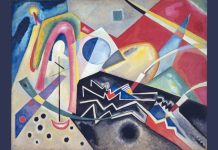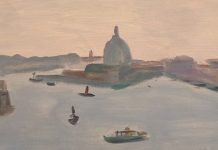Internationally famous for his upside-down paintings, German artist Georg Baselitz (born in 1938) is the first living artist to have an exhibition at the Gallerie dell’Accademia in Venice.
Curated by Kosme de Barañano and occupying seven rooms, “Baselitz – Academy” (running until 8 September) showcases Baselitz’s paintings, drawings, prints and sculptures in a spectacular fashion, thanks especially to his gigantic upside-down portraits of various personalities and his equally large nude paintings. Baselitz, a frequent visitor of Italy and Venice, has been influenced by various Italian Renaissance artists, from Giovanni di Paolo to Rosso Fiorentino and Jacopo da Pontormo, as well as by the legacy of the Academy. As noted by Paola Marini, former director of the Gallerie dell’Accademia, “After the success of the Philip Guston exhibition in 2017, we are pleased to continue the journey by presenting the work of a contemporary master, Georg Baselitz, whose work has been profoundly influenced by the encounter with the history of Italian art as represented at the Gallerie dell’Accademia.”

But Baselitz has another strong connection to Venice: his friendship with Emilio Vedova.
The two artists met in the 1960s in Berlin, where Vedova lived for a couple of years. For this reason, the Fondazione Emilio e Annabianca Vedova decided to celebrate the hundredth anniversary of the birth of the great Venetian artist (9 August 1919 – 25 October 2006) with an exhibition curated by Baselitz himself, who accepted enthusiastically.
After selecting what he deemed to be Vedova’s most representative works, Baselitz had them installed on two facing white walls in the Magazzino del Sale exhibition hall, recently restored by Renzo Piano, thus arranging them into two series of large black-and-white works on canvas which belong to two important phases of Vedova’s complex artistic journey: the 1950s/60s and the 1980s. On one wall are six large square works from the 1980s, characterized by a high-impact and visually explosive style. On the other wall are a series of historic works from the late 1950s and early 1960s.

12 out of the 14 works on display were created using water paint and sand on canvas. Being a great admirer of Vedova, whom he regards as a dynamic, revolutionary artist (a definition that fits Baselitz, too), in 1957 Baselitz bought one of his paintings. The intensity of their friendship manifests itself also in the range of colours and tones used in their paintings – and one can indeed detect the influence of Vedova in Baselitz’s upside-down figures on display at the Academy.


















